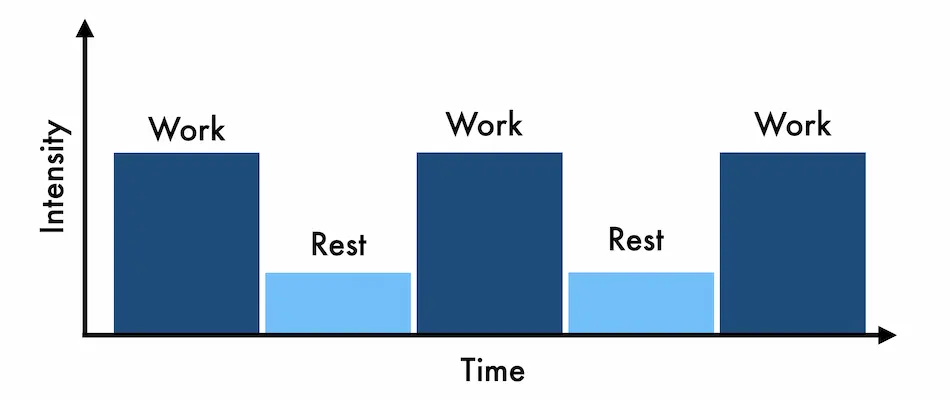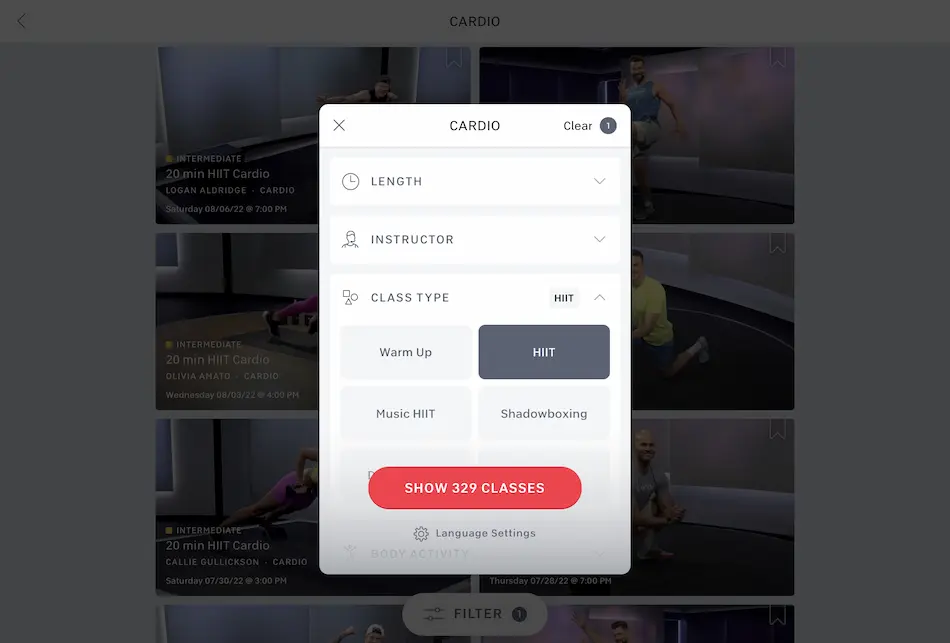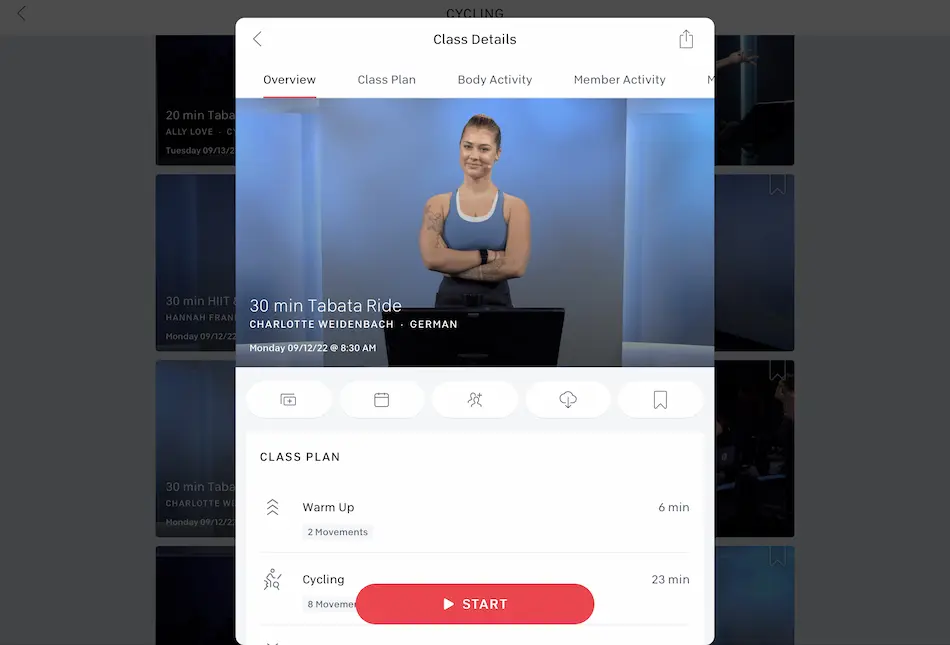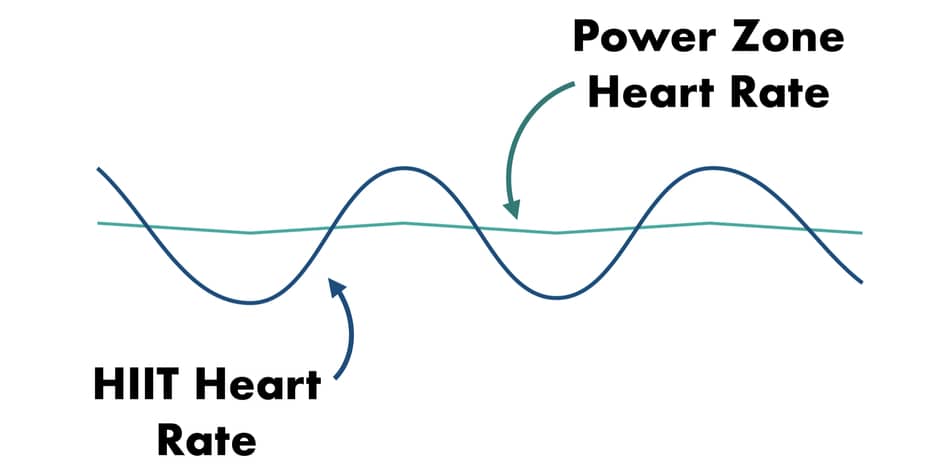Looking for a tough workout? One of the most effective and time-efficient ways to improve health, body composition, and performance on Peloton is by doing high-intensity interval training.
Today I will show you some of the best (and toughest) peloton HIIT and Tabata wokrouts, for the days when you feel like a challenge.

What is HIIT peloton?
HIIT stands for high-intensity interval training.
The peloton has almost 5,000 HIIT classes in their workout library including cardio, strength, running, and cycling.
Peloton HIIT classes work by doing short bouts of high-intensity work (run, cycle, plyometrics) followed by a recovery phase (rest or walk).
Peloton HIIT classes
There are different types of HIIT classes on the peloton. The difference is in the class structure and the level of intensity.
- Intervals
- HIIT and Hills
- Tabata
- Climbs
The class intensity is increased by either adding more speed, resistance or incline.
What are peloton HIIT and Tabata classes like?
The peloton HIIT and Tabata classes are not like other strength or recovery workouts.
- In typical peloton strength classes, the goal is to reach muscle fatigue, extend time under tension, or get this muscle pump at the end of each set.
- In peloton recovery classes, you train with low intensity to facilitate muscle recovery and improve blood perfusion.
HIIT and Tabata are different (see below).

HIIT and Tabata it’s all about the intensity.
The typical HIIT workout elevates my heart rate above 140 BPM.
Of course, even some beginner peloton low-impact rides include short bouts of higher intensity. However, they also have a much longer recovery time.
The majority of peloton HIIT workouts involve climbing, sprinting, or doing circuit training with minimal rest time.
How hard is peloton HIIT and Tabata workouts?
For me, HIIT and Tabata are one of the hardest peloton classes available on the app.
You not only burn more calories in a shorter amount of time, but also you get to train in different heart rate zones (all in one workout).
I also like these wokrouts becasue they save me a lot of time.
I train in the morning so I always run out of time to train (I rarely say that I have too much time for my morning workouts).
How many calories does Peloton HIIT burn?
According to my Garmin watch, you can burn between 13 to 17 calories per minute doing peloton HIIT and cardio.

This means the 30-minute HIIT class can burn between 390 to 500 calories. My PR was 408 kcal (more on that later).
The number of calories will depend on the type of class you do and the effort level you put into the class.
Keep in mind that HIIT is not the perfect solution for burning calories in the long run. If time is not the issue, then I would recommend doing longer endurance rides.
If your goal is to burn as many calories as possible, do long-distance rides that last for 75 to 90 minutes and can burn much more calories than a 30-minute session.
Are Peloton HIIT Workouts Good?
The peloton HIIT workouts are good because they help reduce body fat, improve aerobic fitness, and increase metabolic rate (in a relatively short period of time).
Multiple studies have shown that HIIT is an effective alternative to standard exercise recommendations.
Is Peloton HIIT better than cardio?
It depends.
If you have more time on your hands and you primarily use a peloton for weight loss, I recommend doing steady-state cardio.
If you have less time and you’re not so much focused on the weight loss thing (but you still want to train for health and performance), I recommend going for HIIT and Tabata.
The peloton HIIT can be better than normal cardio, especially for people who are short on time.
Peloton HIIT allows working on aerobic and anaerobic fitness in a short period of time.
Who is Peloton HIIT and Tabata not good for?
I don’t recommend this class for newbies or people who come back from a long break without exercise.
These workouts are more intense so it’s better to start with something easier like low-impact rides or peloton climb rides.
I also don’t recommend these workouts for the elderly or people who have mobility problems.
I’ve written a whole article about peloton classes for seniors that I recommend you check out.
Best Peloton HIIT classes
For me, the best thing about doing peloton HIIT classes is time efficiency.
You can train the full body in just under 20-minutes.
This is also great for people who don’t love to exercise (I find that high-intensity intervals are more fun and less boring than treadmills or ellipticals).
Here is the list.
1. HIIT Cardio

Peloton HIIT cardio can be used on its own as a workout (especially if you’re really crunched on time) or as an addition to your current cycling or running routine.
In a nutshell.
- The HIIT cardio peloton is a series of classes that involve doing full-body exercises with, as well as without the equipment.
- The class duration ranges between 20 to 45 minutes and consists of doing 3-4 exercises back to back, followed by a short recovery time.
For me, cycling on its own can improve my aerobic fitness, but when I add high-intensity intervals, I get much better results.
What I like
I like doing peloton Rock HIIT cardio with Selena Samuela. She has great energy and chooses compound exercises like dumbbell swings or snatches.
Those moves are functional and require multiple muscle groups to work.
She also uses heavy dumbbells, which can elevate your heart rate with minimal repetitions (in under 20 minutes).
And yes, 20-minute peloton rides are effective becasue its enough to increase metabolic rate and stimulate muscle protein synthesis.
I also like the 20-minute Hip Hop HIIT cardio with Adrian. Those classes have a good mix of both bodyweight plyometrics, together with resistance training.
What I dislike
You should not make your entire peloton workout plan based on short 20-minute rides. Doing only 20 minutes workouts isn’t the most optimal way to improve fitness.
If your goal is to get the best results, the peloton cardio HIIT should be used as an addition to either weight lifting or long-distance endurance rides.
2. Tabata classes

Tabata is one of the best peloton classes for weight loss, period.
One class can burn between 400 to 600 calories. In fact, in I did Tabata several times and my personal record was 408 calories in under 30 minutes.
I’ve included this workout in the peloton rides that burn the most calories article, which I recommend you read.
In a nutshell.
- The Peloton Tabata is a series of high-intensity interval classes with a 2:1 ratio of work and resting time.
- The classes involve 20 seconds of max effort, followed by 10 seconds of rest. The Tabata class will usually last between 10 to 45 minutes.
According to studies, Tabata training is one of the most energetically effective high-intensity interval training methods (Tabata, 2019).
Apart from anaerobic improvement, the Tabata workouts help to increase aerobic power comparable to regular steady-state cardio, with less amount of time required.
For me, this is by far the most challenging short workout on the peloton (apart from the peloton FTP test class).
What I like
I like that Peloton has dozens of Tabata classes in their digital app. If you’re looking for something more difficult than HIIT cardio, Tabata is a way to go.
In HIIT, you have more recovery time so your heart rate comes back down quickly.
In peloton Tabata, your recovery time is barely 10 seconds. This means your heart rate is elevated throughout the whole class.
The hardest peloton Tabata ride is the 45-minute class with Robin Arzon. This class is killer.
Her classes are relentless because each time she encourages you not only to increase the cadence but also the resistance.
It includes an 11-minute warm-up, followed by a 33-minute main workout where you sprint for 2 minutes and recover for 1 minute.
What I dislike
The only categories of classes that include Tabata are cycling and running (I wish they would add some Tabata into rowing workouts). To find the Tabata classes head on to the filter tab and search for intervals.
3. HIIT Run
Peloton HIIT run is another interval training workout, but done on the treadmill.
The peloton HIIT run is a workout series designed to work on both aerobic and anaerobic fitness.
The class duration is between 10 to 60 minutes and is divided into three levels that vary in difficulty level from beginner to advanced.
Peloton HIIT run can be found in both tread and outdoor categories.
The difference between HIIT run on the tread and outdoor is that outdoors your only estimate of effort is an RPE scale of one to 10.
On the other hand, the tread HIIT run allows you to precisely select the running pace by choosing the right treadmill speed.
What I like
What I like about the HIIT class is it has a different work-to-rest time ratio.
Some of the hardest HIIT runs are with Becs Gentry, which includes intervals of 5 minutes max effort, followed by a 1-minute recovery walk.
What I dislike
One thing I dislike about these workouts is you have to be “already fit” and have running experience to get the most benefits.
This class is not for beginners.
So keep that in mind.
How often should you do HIIT peloton?
Good question.
To know how often should you use peloton will depend on your fitness level and your goals.
HIIT peloton is good for people who want to add more volume to their workouts, without spending additional time.
You can do peloton HIIT and Tabata 1 to 2 days a week, as long as you have enough low-impact rides and recovery classes like peloton yoga or foam rolling in your weekly workout schedule.
Can I do Peloton HIIT every day?
I don’t recommend doing HIIT classes every day.
People who are busy (and don’t have time for steady-state exercise) can do peloton every day, but not HIIT or Tabata.
These workouts kick ass and take significantly longer for the body to recover. High-intensity workouts around your VO2max are more energy demanding, but also more taxing on the body.
Doing longer high-intensity rides daily can lead to muscle fatigue, poor recovery, and overtraining.
Do Peloton HIIT and Tabata once a week
According to longevity and well-being expert, Peter Attia, M.D., the most optimal frequency for HIIT workouts is one session per week.
This is where you reach the intensity that equals peloton power zone 4 and 5.
At the same time, the rest of the weekly sessions should be around power zone 2 and 3 (low intensity). Here you can maintain blood lactate concentration under 2 mmol/l.
How long should you do Peloton HIIT and Tabata?
I find that on the days when I don’t have much time, doing 10-15 minutes HIIT sessions is enough to increase metabolic rate, without causing muscle fatigue.
Peloton HIIT and Tabata are great for busy days. The whole idea behind HIIT is an alternative for people who are swamped with work.
So if you don’t have time or access to a proper fitness facility when you’re traveling, doing 10 min peloton HIIT is better than doing nothing.
However, if you do have a regular gym workout and you want to add HIIT on top of it, then doing it every day can bring diminishing returns in the long term.
The body needs to have time to recover, and when you have high-intensity workouts on a daily basis it reduces resting time and can lead to injury.
Best Peloton HIIT Instructors
Two of the best peloton HIIT instructors include Selena Samuela and Rad Lopez. I also like Robin and Becs.
Those instructors not only present a variety of well-designed workouts but also keep you engaged and motivated.
What I like about Rad’s classes is that he uses a combination of bodyweight moves that requires speed, good mobility, and balance.
On the other hand, Selena has many compound exercises that use weights.
Peloton HIIT vs Intervals
The difference between peloton HIIT and intervals is that intervals often include prolonged recovery time and moderate work intensity.
The HIIT classes are designed to minimize rest time and maximize heart rate during the workout.
Also, HIIT workouts are the branch of intervals.
This means every HIIT workout is gonna contain interval training in nature, but not all interval training has high-intensity components.
In the table below you can see the main differences between peloton HIIT and intervals.
| Peloton HIIT | Peloton Interval |
|---|---|
| Vigorous intensity Higher work-to-rest ratio Works on anaerobic fitness Suitable for intermediate and advanced people | Low to moderate intensity Similar work-to-rest ratio Works on aerobic fitness Suitable for beginners and intermediate people |
As you can see, interval classes require less intensity and skills than HIIT. However, the Peloton HIIT can be good for beginners, as long as you’re mindful of your abilities.
Peloton HIIT run vs interval run
The difference between peloton HIIT run and Interval run is that interval run has a moderate intensity and can be done by beginners.
It can include light jogging followed by walking time, which is great for people to get started with running.
On the other hand, the HIIT run has a longer and more intense running time.
And because it is much harder to maintain the high-intensity effort for a longer duration, realistically, those classes can be mainly tolerated by skilled runners.
Peloton Power Zone vs HIIT
The difference between the peloton power zone and peloton HIIT is that the power zone is designed to reach and maintain one specific fitness zone for the entire duration of the class.
This requires running or cycling with the same effort for a certain amount of time.
This is very helpful when your goal is to train for a marathon or improve your time for 5K or 10K.
On the other hand, HIIT changes its intensity by having high-effort work, followed by low-intensity work.
This is helpful if your goal is to train anaerobic fitness or get aerobic power with less work time.
Below you can see the graph that illustrates the difference between the peloton power zone and HIIT workouts.

(Both lines represent the intensity level.)
Peloton HIIT vs HIIT and Hills
In Peloton HIIT classes you ramp up the intensity by increasing cadence on the bike or speed on the treadmill.
(Increasing the pace is the main way of making these classes harder.)
In Peloton HIIT and Hills you increase the intensity in a variety of ways.
For example, on the bike, you can increase cadence and resistance, whereas on the tread you can add speed and elevation.
Conclusion
- Doing peloton HIIT workouts on their own or as an addition to your current fitness routine is a great way not only to burn more calories but also to train at a higher anaerobic threshold.
- However, to get the best body composition or performance results, it is better to do longer classes.
- As a whole, over 2,200 rides on the peloton app are HIIT workouts that last between 20 to 45 minutes.
- High-intensity interval training rides include intervals, climbs, hills, and sprints where you increase your output for a short period of time, followed by rest time or low-intensity work.
